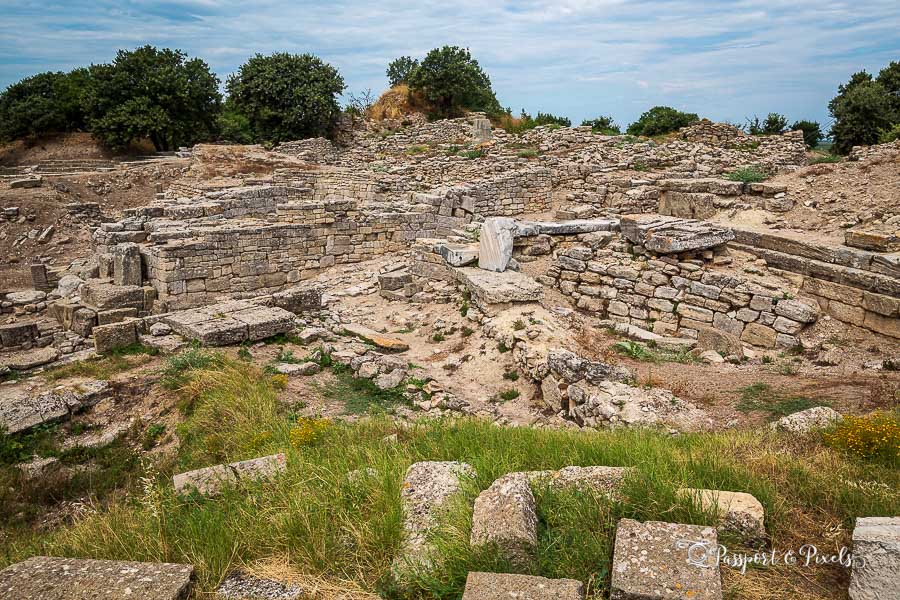
I visited the ruins of Troy Turkey for five days to direct and produce a documentary for Discovery Science Channel. All opinions are my own and all prices correct at the time of writing.
The city of Troy is one of the most famous ancient sites in the world.
Even if you can’t remember any details, you’ll have heard of the Trojan War, and the Trojan Horse, and you might have seen the epic (or epically bad, depending on your point of view) movie starring Brad Pitt and Eric Bana.
But what you might not know is that Troy is not just a fictional location, it’s a real place. Yes, you can actually visit Troy in Turkey and see this legendary city for yourself.
I spent five days there filming for a documentary about Troy, so I got to know the site and its history well.
It’s a fascinating story of brilliant archaeological detective work, and I’m excited to share it with you here.

The story of Troy and the Trojan War
The tale of Troy was first written down in the epic poem The Iliad, written by the Greek author Homer in about 750 BC. In the story, Paris, Prince of Troy, elopes with the famously beautiful Queen Helen of Sparta.
The furious Greeks, led by the warrior Achilles, launch 1000 ships, sail across the Aegean Sea to Troy and lay siege to the city for 10 years.
The war eventually ends by means of a trick: Greek soldiers build a wooden horse and hide inside while the rest of the army pretends to sail away. The Trojans are tricked into thinking the horse is a parting gift and bring it inside the city walls.
At night, while everyone is drunk from celebrating their victory, the Greeks jump out and let the rest of the army into the city, which is destroyed.
It’s one of the most famous stories ever told, but is it just a fairytale, or is it based in truth?
Before I get to the practicalities, I think if you are going to visit Troy, you’ll get a lot more out of it if you know a bit about the history of the site and how it was discovered.
If you don’t care about this, skip down for practical information to help you plan your visit.

Searching for the ancient city of Troy
For centuries, archaeologists hunted for proof that Troy really existed. Finally, in 1870, a man named Heinrich Schliemann uncovered the remains of a large Bronze Age city buried beneath a huge mound in northwest Turkey.
It sat near a small town in Turkey called Hisarlik (or Hisarlık in Turkish), on the Turkish Aegean coast, about 3 miles from the southern entrance to the Dardanelles Strait.
When he excavated the ruins, Schliemann found a hoard of gold treasures that he was convinced was the gold of Priam, the King of Troy. The discovery made headlines around the world.
In his eagerness, Schliemann famously hacked a huge trench through the site, almost certainly destroying vital clues to the city’s history.
The gold he found – which it turns out was far too old to be Priam’s treasure – ended up in Russia and has yet to be returned.
But was Schliemann right? Is this really the city of Troy?

Was Troy a real city?
How did archaeologists know that these really were the ruins of Troy, and not some other city?
For this to be the real city of Troy, it needed to be the right size, the right age, and in the correct location to match Homer’s description in The Iliad.
The city certainly fitted the description. It has huge defensive walls with fortified watchtowers enclosing a wealthy citadel. There’s a wide main street and a gate that is wide enough for two chariots to enter side by side, just as Homer described.

But there was a problem: Troy was supposedly home to up to 10,000 citizens, and this citadel was too small.
When archaeologists from the University of Pennsylvania searched outside the main walls of the citadel, they solved the problem.
Here they found evidence of a residential area, with houses and pottery. This would be where the common folk live, while the elites – Priam, Helen, and Paris from the story – would have lived in the fortified citadel.
In total, the city covers 75 acres and is large enough for 10,000 inhabitants. It’s definitely big enough to be Troy.

Is it old enough to be Troy?
When archaeologists excavated the citadel mound, they discovered that this is not just one city, but nine, built one on top of the other: nine layers of civilisation lasting 4000 years and going all the way back to 3000 BC.
One of them, the one in Layer Six, dates to around 1250 BC which exactly fits the time Homer was writing about. So this city is the right age to be Troy.

Is it in the right location to be Troy?
In The Iliad, Homer describes the location of Troy very precisely. It’s next to the Aegean Sea and the Dardanelles Strait and directly across from Greece.
It’s also close to the island of Tenedos, said to be where the Greek Army hid when they pretended to sail away. It’s also close to Mount Ida, where, in the story, the gods Zeus and Hera sat and watched the Trojan War unfold.
No other city has been found in this area that fits the size and description, so experts are confident this must be the ruins of Troy.
But there’s a problem: it’s four miles from the sea. So how can this be Troy, which, according to Homer, was right by the beach?
Again, archaeology solved the mystery. When experts examined soil samples, they discovered marine fossilized layers and seashells which show that this area used to be underwater.
The flat plain that you can now see when you look out from the top of the citadel used to be a bay, but over millennia the sea has retreated.
This city used to be right on the water. Final evidence that this probably is the lost city of Troy.
Want to see more of my photography or travel writing? Have comments or questions? Come follow me on Instagram, Threads or Bluesky and share your thoughts!

Was the Trojan War real?
So, archaeologists are pretty certain that Troy is a real place. But did Homer invent his epic tale of the Trojan War, or did it really happen?
According to the story, the Greek army camped outside the walls of Troy for ten long years. Fierce battles were fought, and many died. But to prove this really happened, archaeologists needed to find evidence.
The first clue was in the defences. The walls of the city were once five metres thick and nine metres high, with towering gateposts.
Outside the city walls, experts also found the remains of a U-shaped fortification ditch, which would have been built to defend the city from attackers on horseback or in chariots.
All these defences make it clear that the people living in the city were worried about attacks from outside forces.
Excavations also unearthed piles of slingshot pellets – typical siege defence weapons – as well as bronze arrowheads and spearheads more than 3000 years old.
It’s clear that at some point in its history Troy came under attack. It might not have been the 10-year siege Homer describes in his story, but that could well have been the war that inspired his tale.
Are you inspired too? Want to know how to visit Troy? Carry on reading to find out…
Or just click this link to book this brilliant full-day Troy tour from Istanbul.
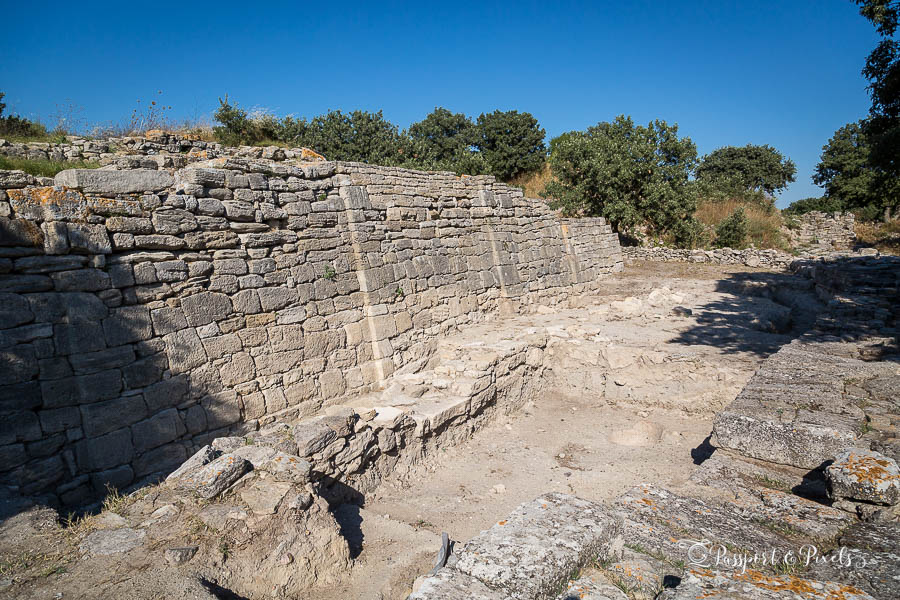
Visit Troy in Turkey: Practicalities and FAQs
Can you visit Troy?
As you can see from these photos, the answer is yes, you CAN visit the ruins of Troy!
Just like many of the amazing ruined sites in Turkey, you can buy a ticket and come inside to walk around this amazing ruined city. Drive there and walk around by yourself, get a local guide to show you around, or visit on a tour from Çannakale or Istanbul. The choice is yours!

Where IS Troy IN TURKEY?
The ancient city of Troy sits on the Aegean coast of Turkiye, about 3 miles from the southern entrance to the Dardanelles Strait, just down the road from the village of Tevfikiye, and about 20 miles from the city of Çanakkale (pronounced Cha-NAK-a-lay).
The site is about a 5-6 hour drive from Istanbul or 4 hours by car from Izmir
In Turkish the name for the site is Hisarlik or Hisarlık (pronounced His-AR-look).
How long does it take to visit Troy Turkey?
The ruins of Troy have been well-marked-out for tourists, with a clear route to follow that takes you all round the site via gravel paths or a wooden boardwalk. If you walk at a reasonable pace and don’t stop much the entire circuit will take you about an hour.
If you want to take it at a more leisurely pace, I’d allow two hours for your visit.
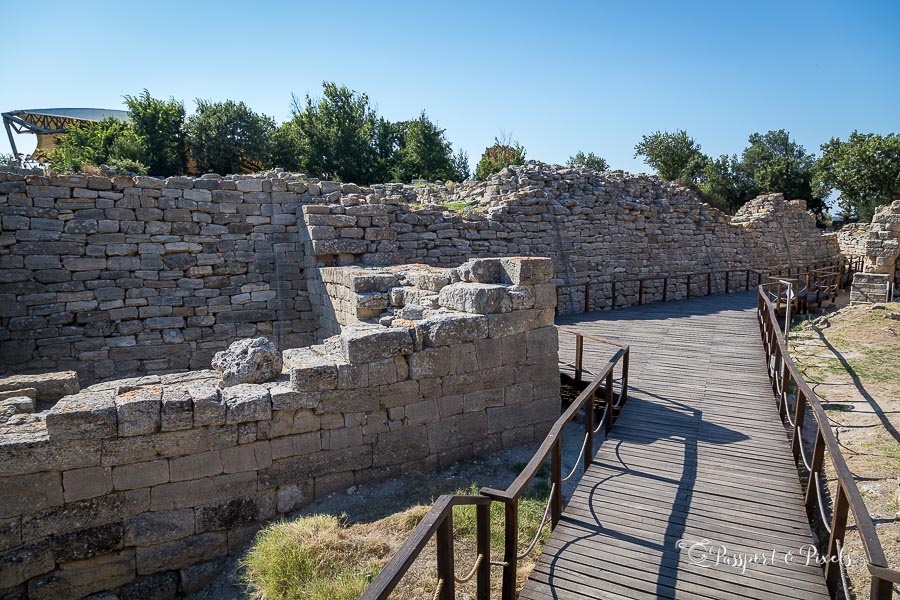
What is there to see when visiting Troy in Turkey?
Trojan horse model
The main entrance to the ruins of Troy has imposing visitor gates and a small shop and café. Behind that is a large model wooden horse, imagining what the famous Trojan Horse might have looked like.
It’s not authentic in the slightest, but you can go inside and it’s a bit of fun, especially if you have kids.

Main gate and walls of Troy
As you walk around the archaeological site of Troy you may find yourself getting very confused.
To be completely honest, even after weeks of research, to me it still pretty much all looked the same, and it’s hard to understand the different city layers and different historical periods.
But you can definitely make out the imposing walls of Troy city, the south gate, and eight-metre-high north-east bastion.
With a bit of imagination, you can almost picture the Trojan defenders inside the citadel looking out at the Greek army camped on the plain below.

Layers of Troy
One reason why the archaeological site of Troy is confusing is because there’s not just one city, but nine, each one built on top of the one before. Troy I dates back to about 3000 BC, Troy II (the layer that Schliemann excavated) is from about 2500 BC.
The bit most people are interested in, the Troy from Homer’s story, is Troy VI, which dates back to the Late Bronze Age, about 1700–1180 BC.
The ninth and final period of occupation was under the Romans, up to about 500 AD, after which the city was completely abandoned and left to become buried by the sands of time.
At one point in the circuit you can see all these layers clearly marked, so you can get a sense of how the city was redeveloped repeatedly over the centuries.

Troy Museum
The Troy Museum is located 800 m from the archaeological site at Tevfikiye village. It was opened in 2018 and houses all the archaeological treasures from the 4000 years of the city’s history, as well as finds from other nearby sites.
It’s a really interesting collection in a cleverly-designed modern building, and definitely worth a visit while you are at Troy. The museum shop is also much better than the small tourist shop at the main site.




When is the best time to visit Troy?
Most large tour groups arrive in the morning when the site opens and stay for about 1-2 hours before heading off again. That means, if you want to avoid the crowds, you should avoid turning up early.
Either aim for late morning, or if it’s the middle of summer and you want to avoid the heat, the end of the day is a good time to visit, when the crowds have left and the light is nice.
Of course, if you visit in winter you should be able to avoid the crowds entirely.
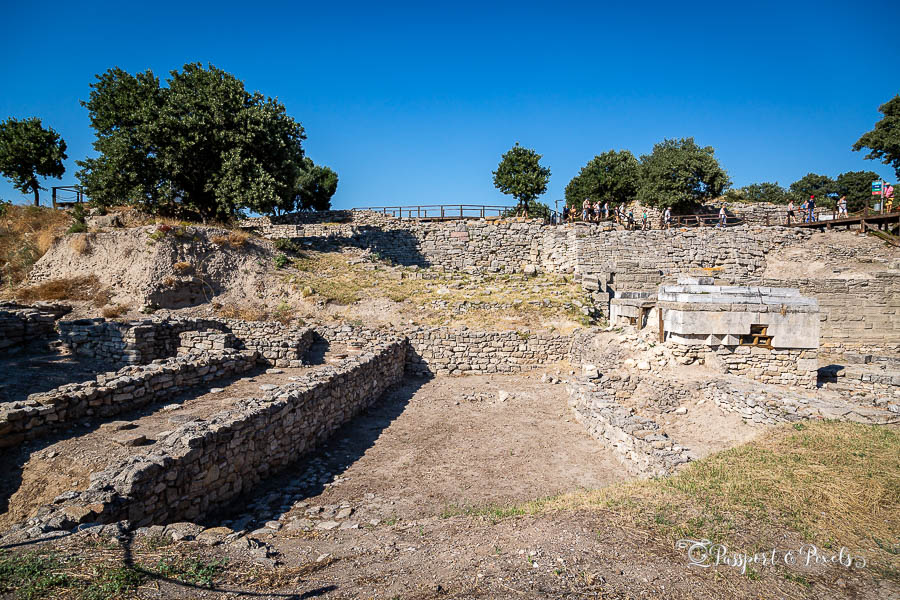
What should I wear to visit ancient Troy?
Although the paths are clear and easy to walk on, it’s quite a long walk to get all the way round, so wear comfortable clothes and shoes. Make sure you take suncream, water and a hat; it can get very hot and there’s little shade.
How much does it cost to visit Troy?
Entry to Troy ruins costs 25 Lira for adults, under 12s go free. If you are visiting a lot of Turkey’s ancient sites, you might be better off buying the Turkey Museum pass, which costs 315 Lira. It gives you admission to 300+ museums and is valid for 15 days.
Read more: The Best Ancient Ruins in Turkey

How to get to Troy ruins, Turkey
Troy is located near the small town of Hisarlik Turkey, which is about 20 miles from the nearest major city, Çanakkale.
Minibuses from Çanakkale take about 45 minutes and depart from the local bus station every hour from 7 am until 3 pm and cost 7 TL per person. Return buses depart from Troy every hour from 9.30 am to 5.30 pm.
If you’re taking a Turkey Road Trip and have a car, there is parking by the main entrance to Troy ruins.
Getting to Troy from Istanbul
It’s about a 6 hour drive from Istanbul to Troy. You need to go round the Sea of Marmara, so you can either head round the north side and then get a ferry across the Dardanelles Strait from Kilitbahir to Çanakkale, or drive around the south side via Bursa.
The north route is a shorter drive but will involve a wait for the ferry. Ferries depart about every 30 minutes and the crossing takes about 15 minutes.
This is the route we did, and the ferry ride from Kilitbahir to Çanakkale was very scenic, so I’d recommend it.
You can also visit Troy city on a full-day trip from Istanbul. Tours leave at 7 am and get back very late – it’s a long day.
If you prefer, you can also do a two-day trip that includes the battlefields of Gallipoli as well.

Is Troy worth visiting?
There are lots of great reasons to visit Troy – if only for the wonderful links to the greatest of Greek literature and mythology. It’s also one of the most famous archaeological sites in the world.
However, it isn’t terribly well-preserved (it’s very old, after all!), and there are many other ancient sites in Turkey that are much more impressive.
I would say that unless you are a real archaeology or Greek mythology fan, it’s probably not worth making a special trip all that way just to visit Troy.
But if you are passing through the area then it’s a fascinating place to stop in and see for an hour or two.

Other things to visit near Troy ancient city
Viewpoint near Kepez, Çanakkale
If you’re driving south from Çanakkale towards Troy city, about 3 miles outside the city you pass through the town of Kepez. As you rise up the hill, on the right-hand side there is a parking area with an amazing viewpoint over the Dardanelles, the narrow strait that connects the Aegean to the Black Sea.
Today it’s an important shipping channel and you will often see big container ships passing though. In Homer’s time it was also a trade route, and it’s thought that Troy was an important gateway city, where ships would stop to restock and do repairs while waiting for favourable winds to make the journey through the strait.
The Canakkale viewpoint is worth a quick stop on your Troy visit.

Trojan Horse Statue, Çanakkale
After Brad Pitt and co finished making their epic Troy movie, they donated their huge wooden horse to the city of Çanakkale. It now stands on the waterfront, and no visit to Troy is really complete without a photo standing in front of this cool piece of movie memorabilia.
If you’re already in Çanakkale, it’s really easy to book a day trip to Troy from here.
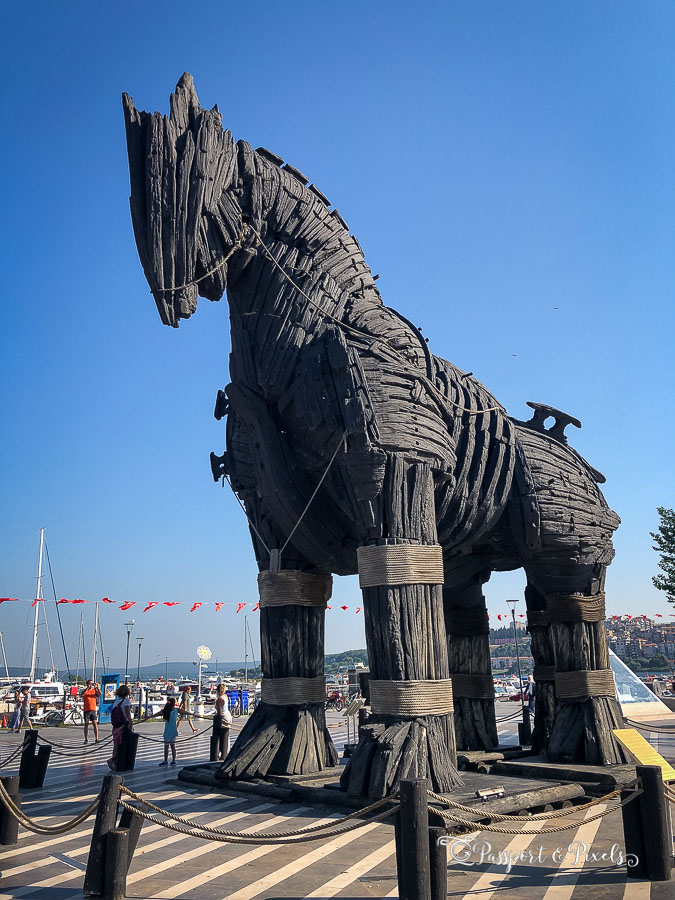
Gallipoli memorial
Fans of First World War history will know about the Gallipoli campaign, when the Allies, including many Australians and New Zealanders, landed on the Gallipoli peninsula in 1915 and were defeated with approximately 250,000 casualties on each side.
Today, a memorial stands on the north side of the Dardanelles Strait, and you can also visit the landing beaches, battle sites and cemeteries of fallen Allied soldiers. For readers interested in 20th century history, this area is one of the top destinations in Turkey.
Tours of Troy and Gallipoli together depart regularly from Istanbul or Çanakkale.

Where to stay near the ancient city of Troy
MID-RANGE: Iris Hotel, Çanakkale



We spent the duration of our shoot at the Iris Hotel, Çanakkale, which is about a 15-minute drive from the site. This beachfront resort hotel boasts comfortable rooms, with a spa and swimming pool.
The hotel itself is pleasant and clean, the food in the restaurant was OK but nothing special, but the big attraction for me was the wide sandy beach with sun loungers, perfect for cooling off in the water after a hot, sweaty day at the ruins of Troy.
If you prefer beach clubs or all-inclusive resorts from where you can then add on a day trip to Troy, try a holiday operator like SNO – who have a good selection of Türkiye accommodation to choose from.
Rating: ⭐️⭐️⭐️⭐️ | 🏨 Booking.com rating 8.6 | 💻 Click here to see reviews
Other great hotels near Troy Turkey
BUDGET: Çanak Hotel



Located in Çanakkale city centre, this budget-friendly hotel offers clean, modern rooms, an excellent breakfast, and friendly staff. It’s also conveniently close to where the ferry drops you off after crossing the strait, and the rooftop restaurant has great views over the port.
Rating: ⭐️⭐️⭐️ | 🏨 Booking.com rating 8.6 | 💻 Click here to see reviews
MID-RANGE: Set Özer Hotel



Situated near the Çanakkale waterfront and clock tower, this small hotel has clean, nicely decorated rooms, and delicious breakfast. Its central location makes it easy to explore the town and nearby historical sites. They offer free bikes, free private parking, a garden and a shared lounge.
Rating: N/A | 🏨 Booking.com rating 9.1 | 💻 Click here to see reviews
LUXURY: Kolin Hotel Spa & Convention Center



A luxurious hotel with spacious rooms, multiple pools, and a full-service spa, Kolin Hotel offers both comfort and elegance. The hotel’s stunning sea views and proximity to the ancient city of Troy make it a top choice for travellers and history lovers.
Rating: ⭐️⭐️⭐️⭐️⭐️ | 🏨 Booking.com rating 9.2 | 💻 Click here to see reviews
LUXURY: DoubleTree by Hilton Çanakkale



Offering luxurious rooms and top-notch amenities, including a spa and wellness center, this Hilton hotel provides a high-end stay with modern comforts. Its central location makes it ideal for exploring both the ancient ruins of Troy and the city of Çanakkale.
Rating: ⭐️⭐️⭐️⭐️⭐️ | 🏨 Booking.com rating 9.0 | 💻 Click here to see reviews
Where to eat near the ancient site of Troy
At lunchtime, there are a handful of tourist food places about 100 m from the main entrance to the site, just where you turn off the main road.
All of them serve the same tourist fare of pide (Turkish flatbread with toppings), kofta, Turkish mezze and salads, and chips. We ate at one or other of them for lunch every day and they were fine.
Since the food in the restaurant was buffet-style and not that great, we wandered up the road to the small village of Güzelyalı, where we found the Raja Restaurant Güzelyalı. Here they served fresh fish and delicious mezze, all accompanied by the most wonderful sunset views over the water.
We loved this place and went back several times, but there are other similar ones along the same strip.



Watch the Troy documentary
If all this has piqued your curiosity and you want to find out more about the story of Troy and the Trojan War, head over to my website where you can watch clips from the documentary and see photos from the shoot.
Or you can watch Unearthed: Lost City of Troy on the Science Channel website (but you’ll need a subscription to do this, sorry!)

Where to next?
If you love archaeology or want to know more about my work as a documentary producer, here are a few more posts you might enjoy…
- An Unhelpful Guide To… Aztec Ruins In Mexico
- An Unhelpful Guide to… Tepoztlan, Mexico
- An Unhelpful Guide to… Herculaneum
- A Turkey Road Trip On The Aegean Coast
- Gordion in Turkey: City of King Midas and the Golden Touch
- Aspendos Ruins And Theatre In Turkey: The Essential Guide
- How To Visit Perge Ancient City Ruins In Antalya, Turkey

Want to see more of my photography or travel writing? Have comments or questions? Come follow me on Instagram, Threads or Bluesky and share your thoughts!
Buy me a coffee
Did you enjoy this website or find it useful? If you did and fancy showing your appreciation, that would be amazing!
A small token of support helps keep Passport & Pixels going, so I can carry on creating free content for travellers like you. Also, it makes my day! Thank you!
My favourite travel tools and brands
To help you organise your trip, here’s a short list of some of the brands and tools I use over and over again when I’m planning my travels. You can see more on my Travel Resources page.
- Booking.com: A huge range of hotels to choose from, often with free cancellation. If you book hotels regularly you can earn discounts. I’m on Genius Level 3 which gets me 20% off!
- Expedia: Another great place to find hotels and Expedia also sell flights, car hire, and loads more all in one place.
- Skyscanner: The only place I ever go to search for flights and compare prices.
- Flight Centre: Booking a more complicated route? Let Flight Centre organise it for you (and deal with the drama when something goes wrong).
- Priority Pass: I love having access to 1600+ airport lounges when I fly, allowing me to enjoy my time at the airport. Buy through my link and you get up to 30% off!
- Airalo: Say goodbye to ridiculous mobile roaming charges. Did you know you can now buy an e-SIM, install it in your phone before you leave home, and then use data abroad at local prices? Game changer. Get US$3 credit with code BELLA5735.
- TourRadar: If you prefer group travel and organised tours, TourRadar has a huge range of fantastic tours from respected operators. They’re very helpful and have 4.5 stars on TrustPilot.
- Viator: Part of the TripAdvisor brand, Viator is another great place to search for group adventures and day trips.
- GetYourGuide: A great place to find local tours and day trips in your destination.
- Wex Photo Video: The UK’s best camera gear store. Quote my name – Bella Falk – to get £20 off your first purchase.
- Ellis Brigham: Looking for good quality backpacks, travel clothes and other gear? Ellis Brigham is where I buy almost all of mine.
- Rentalcars.com: Part of the Booking.com family and the world’s largest online car rental service, with 24/7 customer service.
- World Nomads Travel Insurance: I never ever travel without travel insurance and nor should you!
Liked this Troy Turkey post?
Social shares help support my hard work! You can share via the buttons at the bottom, or pin this handy Pinterest Pin. Thank you!



Found ourselves unexpectedly in Canakkale and heading south so this story was a great find.
Thanks for reading! Check out my Turkey road trip post as well for more ideas of things to do in that part of the world. Have a great trip!